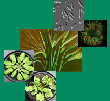Arabidopsis halleri as a model for metal hyperaccumulation
 A. halleri is a hyperaccumulator growing on metal-contaminated sites in Central Europe. It occurs, for instance, in many places in the Harz mountains that are metal-rich due to geological or anthropogenic influences. A. halleri is closely related to the model species of modern plant genetics, Arabidopsis thaliana. We are taking advantage of this relatedness by using the powerful tools developed for A. thaliana. For instance, we have recently initiated comparative transcript profiling of the two species using Affymetrix GeneChips. This has (i) demonstrated the feasibility and usefulness of cross-species hybridizations and (ii) led to important insights into the molecular mechanisms of metal hyperaccumulation (Weber et al., 2004; Weber et al., 2006).
A. halleri is a hyperaccumulator growing on metal-contaminated sites in Central Europe. It occurs, for instance, in many places in the Harz mountains that are metal-rich due to geological or anthropogenic influences. A. halleri is closely related to the model species of modern plant genetics, Arabidopsis thaliana. We are taking advantage of this relatedness by using the powerful tools developed for A. thaliana. For instance, we have recently initiated comparative transcript profiling of the two species using Affymetrix GeneChips. This has (i) demonstrated the feasibility and usefulness of cross-species hybridizations and (ii) led to important insights into the molecular mechanisms of metal hyperaccumulation (Weber et al., 2004; Weber et al., 2006).  The comparison revealed that several genes encoding known metal homeostasis factors, among them metal transporters and enzymes involved in metal chelator synthesis, are constitutively expressed at a much higher level in A. halleri. This led us to hypothesize that the molecular mechanism behind metal hyperaccumulation might be a de-regulation of metal deficiency responses. It is an emerging picture that plant adaptation to extreme environments is mostly a regulatory phenomenon and our microarray data lend further support to this. It is now of paramount importance to elucidate the molecular basis for this altered regulation.
The comparison revealed that several genes encoding known metal homeostasis factors, among them metal transporters and enzymes involved in metal chelator synthesis, are constitutively expressed at a much higher level in A. halleri. This led us to hypothesize that the molecular mechanism behind metal hyperaccumulation might be a de-regulation of metal deficiency responses. It is an emerging picture that plant adaptation to extreme environments is mostly a regulatory phenomenon and our microarray data lend further support to this. It is now of paramount importance to elucidate the molecular basis for this altered regulation.


